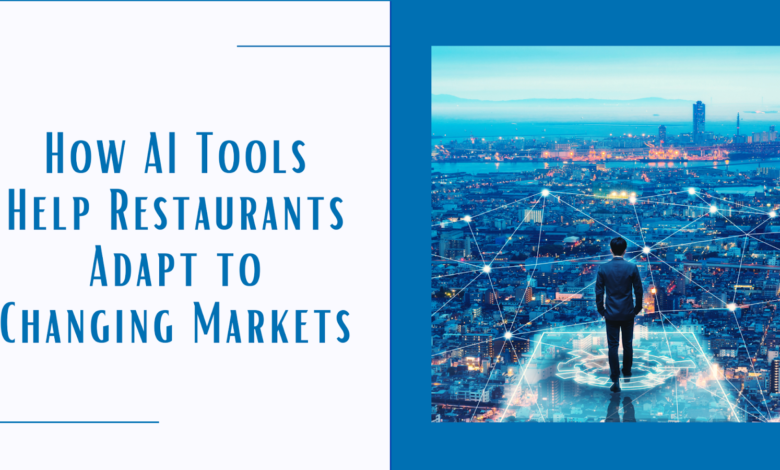How AI Tools Help Restaurants Adapt to Changing Markets

Are you a restaurant owner or manager constantly struggling to keep up with shifting customer demands and market trends? Staying ahead of these changes is crucial for success. Fortunately, AI in restaurants is providing powerful tools to help establishments adapt quickly and thrive.
From real-time market analysis to personalized customer experiences, AI tools for restaurants are revolutionizing the industry. This blog post will explore how AI is empowering restaurants to conquer evolving challenges.
This blog post explores the transformative impact of AI in restaurants and how it’s empowering businesses to conquer evolving challenges through data-driven strategies and intelligent automation. Keep reading to uncover AI’s game-changing potential!
Dynamic Pricing Strategies
AI-driven dynamic pricing strategies allow restaurants to continuously adjust menu prices based on real-time demand, competitor activity, economic factors, and other market variables. This data-driven approach ensures prices are optimized for maximum profitability while aligning with customer expectations.
Studies show that AI dynamic pricing can increase profitability by 10-15% and customer satisfaction by 20%. By letting AI handle complex calculations, restaurants can nimbly adapt pricing in response to fluctuating costs of goods, seasonal demand shifts, and competitors’ moves.
One case study of AI in restaurants found a 10% sales increase after implementing AI-based dynamic menu pricing aligned with customer preferences and market conditions. The AI system could raise prices on high-demand items during peak hours while offering discounts on slower-moving dishes, maximizing revenue.
Personalized Customer Experience
In the era of customization, AI tools excel at delivering personalized customer experiences that drive loyalty and sales. Using data on past orders, dietary preferences, feedback, and online behavior, AI can provide tailored greetings, customized product recommendations, smart issue resolution, and one-to-one marketing.
The impact is substantial – personalized recommendations from AI can boost sales by up to 20%. Furthermore, AI customer engagement tools like those from Bloom Intelligence have increased customer return rates by over 37% by precisely targeting at-risk guests with tailored outreach.
For example, an AI system could greet a loyal customer by name, recommend their usual order plus new items matching their tastes, flag any dietary restrictions, and proactively resolve any issues from prior visits – creating an exceptional, bespoke experience. Restaurants are even exploring an answering service for restaurants powered by AI to provide 24/7 availability for phone answering and reservation booking without hiring additional staff.
Inventory and Supply Chain Optimization
AI inventory management for restaurants applies predictive analytics to forecast demand accurately while factoring in seasonality, promotions, weather, and more. This allows for just-in-time inventory arrivals, reducing waste, spoilage, and excess storage costs.
The numbers highlight AI’s impact – it can cut food waste by up to 20%. Dishoom, a London restaurant chain, implemented an AI inventory tool and reduced food waste by a substantial margin while keeping ideal stock levels.
Beyond inventory, AI optimizes the entire supply chain from procurement to warehousing to last-mile delivery. It analyzes historical data, real-time supplier analytics, and demand forecasts to streamline ordering, maintaining ideal stock levels without tying up excess working capital in bloated inventories.
By reducing waste, optimizing stock levels, and making data-driven supply chain decisions, AI helps restaurants recoup 5-10% of their annual food costs – a substantial boost to profitability.
Staffing and Human Resource Management
Labor is often a restaurant’s biggest controllable expense. AI staffing solutions help optimize scheduling and workforce allocation using predictive analytics. By forecasting future demand based on factors like seasonality, events, weather, and historical data, AI ensures adequate staffing without overstaffing.
AI also streamlines recruiting and hiring processes:
- Automated applicant screening and ranking
- Customized interview questions and tests
- Bias-reduced evaluation of candidates
This AI-driven approach has enabled up to 20% reductions in labor costs for restaurants by precisely matching staffing to demand. Managers stay focused on higher priorities while AI juggles the complex scheduling puzzle.
Digital Marketing and Customer Outreach
AI for restaurant marketing takes the guesswork out of campaigns. AI analyzes vast data sets to identify target audiences, optimize ad creative, and measure effectiveness in real time. Campaigns self-adjust based on performance data, investing more in top-performing channels.
According to Tripleseat, AI-enhanced marketing campaigns boost foot traffic by 20-30% compared to traditional methods. AI’s ability to micro-target audiences and dynamically shift strategies based on results amplifies marketing ROI.
Beyond acquisition, AI nurtures customer relationships through automated, personalized outreach at scale:
- Triggered campaigns for birthdays, reactivations, VIP appreciation
- Increased customer lifetime value
Real-time Market Analysis and Trend Prediction
One of the biggest advantages of AI for restaurant marketing and management is its ability to analyze vast amounts of data and detect emerging trends. AI algorithms can process sales data, social media activity, review sentiment, and countless other data points to forecast consumer preferences.
An excellent example is Starbucks’ “Deep Brew” program, which provides tailored product suggestions to customers based on their purchase history and preferences. By tapping into AI sales forecasting for restaurants, Starbucks stays ahead of trends.
Future Projections and Benefits of AI
Looking ahead, AI’s impact on the restaurant sector is projected to be immense. The global AI in the food and beverage market is forecasted to reach USD 311.6 Billion by 2033. Here’s a visual representation of the market growth of AI in food and beverage from the year 2023-2033:
As AI evolves, we can expect innovations like:
- Immersive AR/VR dining experiences
- Personal AI dietary assistants
- Automated quality control and food safety monitoring
- Predictive analytics for near-future trend forecasting
- Robot servers and automated food preparation
The possibilities are vast for implementing AI in restaurants to reshape operations, customer experience, and profitability.
FAQ
1. How does AI detect and adapt to new market trends?
AI algorithms ingest data from countless sources like sales figures, social media, reviews, search trends and more. Using machine learning, AI models can detect patterns that signal emerging trends. Predictive analytics then forecast how these trends may evolve, allowing restaurants to adapt menus, pricing, marketing and more.
2. What are the typical costs of integrating AI tools into restaurants?
Integration costs can vary based on the specific AI tools, restaurant size and existing technology stack. Generally, you can expect:
- Software/Platform Fees: $100 – $5,000+ per month
- Implementation & Customization: $5,000 – $25,000+
- Training & Change Management: $2,000 – $10,000+
Many vendors offer scalable packages for different budgets.
3. Can small restaurants benefit from AI or is it only for large chains?
Absolutely – the scalability of modern AI solutions makes them viable for restaurants of all sizes, not just major chains. There are AI tools designed specifically for small/medium establishments at affordable costs. The key is finding the right AI vendor that fits your requirements and budget.
Conclusion
The restaurant industry is rapidly evolving, and AI tools offer a powerful advantage for establishments looking to stay ahead of the curve. From dynamic pricing strategies and personalized customer experiences to inventory optimization, staffing solutions, and real-time market analysis, AI empowers data-driven decision-making and intelligent automation.
As the adoption of AI in restaurants continues to grow, businesses that embrace these technologies will be well-positioned to conquer emerging challenges, delight customers, and maximize profitability. Whether a small eatery or a large chain, integrating AI tools can be a game-changer for adapting to shifting market demands and delivering exceptional dining experiences that keep patrons coming back for more.



